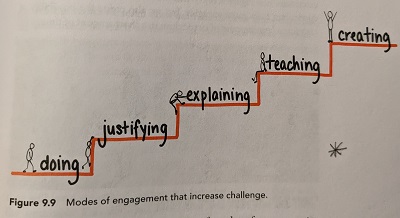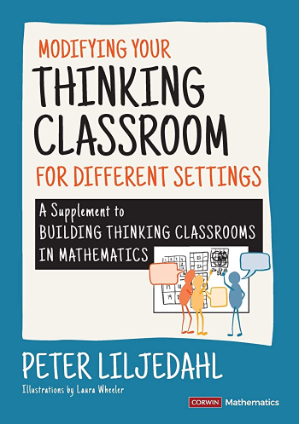- MN ABE Connect
- Archive
- MCTM 2023 Spring Conference Highlight: Building Thinking Classrooms
 June 22, 2023
June 22, 2023
MCTM 2023 Spring Conference Highlight: Building Thinking Classrooms
Lindsey Pust, Numeracy & Special Projects CoordinatorIn April, over 800 people gathered at the annual K-12 Minnesota Council for Teachers of Mathematics (MCTM) Spring Conference in Duluth. Adult Education had a strong presence this year with 28 practitioners in attendance and 6 presentations delivered by ABE teachers!
 By far, the hot topic in everyone’s mind after the conference was Peter Liljedahl’s symposium and keynote on Building Thinking Classrooms.
By far, the hot topic in everyone’s mind after the conference was Peter Liljedahl’s symposium and keynote on Building Thinking Classrooms.
In the very beginning of his book Building Thinking Classrooms in Mathematics, Liljedahl says,
“Thinking is a necessary precursor to learning, and if students are not thinking, they are not learning.” (page 5)
So what does he propose as strategies for fostering classrooms where student thinking is at the forefront? From Liljedahl’s extensive 15-year research through partnerships with 40 different classrooms in 40 different schools, 14 teaching practices emerged. These practices have everything to do with intentionally uprooting classroom norms that communicate to students that their job is to mimic and “get” from teachers… and actually not think.
While I believe all of us would agree that fostering student thinking is of utmost importance, it was amazing to realize (at least for me personally) how insidious some of these traditional classroom norms are that actually prevent students from thinking. I am now seeing aspects of teaching differently – aspects that I didn’t really think twice about before.
14 Teaching Practices for Enhancing Learning
In his book, Peter Liljedahl encourages teachers to examine how the following 14 areas affect student thinking:
- What types of tasks we use
- How we form collaborative groups
- Where students work
- How we arrange the furniture
- How we answer questions
- When, where and how tasks are given
- What homework looks like
- How we foster student autonomy
- How we use hints & extensions
- How we consolidate a lesson
- How students take notes
- How we choose to evaluate
- How we use formative assessment
- How we grade
One that particularly stood out to me was practice #11: how students take notes in class. What are teachers often doing? Where are they often positioned in the room? What are students often doing? Where are they positioned in the room? Many times, teachers are up at the board writing notes as the class works through a lesson, a problem, an example, etc. Students are copying what the teacher is writing as they model for students how to take notes.
However, what if this modeling of note-taking is actually doing the thinking for students and not inviting them into the process of consolidating and making sense of ideas? Peter Liljedahl argues that by and large the latter is happening in classrooms. One of the several strategies he offers for inviting students to think when note-taking is to provide at least 10 minutes of time at the end of a lesson for students to record their thoughts in response to this question:
“What are you going to write down now, so that in three weeks, you will remember what you learned today?”
Following up at a later date with a task that requires the notes that the students took reinforces the usefulness of those notes and may help students determine what kind of information is useful to write down in the future.
When visuals hamper visualizing
Liljedahl makes statements throughout his book (and in-person at the conference!) that cause me to pause and think. For example, he says,
“If we want our students to think visually, we need to stop giving them visuals.”
Wait, what?! That doesn’t make any sense. Or does it? If we always allow students to use visuals as a support when working on problems, they never have to actually visualize what is happening in their minds. Visuals are a good thing! But they need to be taken away sometimes.
 Modes of engagement
Modes of engagement
Another example of me “pausing and thinking” has to do with modes of engagement. Liljedahl argues that the reason so many students struggle to explain how they solved a problem is that we ask students to jump right from doing to explaining. However, we jump over the importance of students justifying their answer before explaining their work.
That idea totally resonated with me! I don’t know about you, but I’ve often had students look at me with blank stares or show me a blank paper after I ask them to explain their work.
The “thinking classroom” in different settings
 Liljedahl’s 14 teaching practices have prompted me – and all the MCTM attendees! – to think about the profound impact that a number of “little” things we do in the classroom has on student thinking.
Liljedahl’s 14 teaching practices have prompted me – and all the MCTM attendees! – to think about the profound impact that a number of “little” things we do in the classroom has on student thinking.
And while these practices emerged from K-12 classrooms, they are applicable to all learning. In fact, Peter Liljedahl wrote a supplemental book called Modifying Your Thinking Classroom for Different Settings. In this supplemental book, he offers practical suggestions for modifying the thinking classroom for virtual and hybrid settings, independent learning and more. This supplemental book nicely addresses how we can incorporate these practices into our ABE settings in meaningful and practical ways!
If you are interested in learning more about Building Thinking Classrooms, I highly recommend the books!
Note: the supplemental (blue) book relies on your understanding of the 14 teaching practices laid out in the original (orange) book.
Upcoming Math Events
- CCRS Math Foundations at Summer Institute: IN-PERSON WORKSHOP for those who have yet to complete CCRS Math Foundations!
- Math-On-A-Stick at the State Fair: volunteer and receive a free admission ticket!
- Math Institute 2023: Friday, September 29 (virtual)
- Sign up for the Math & Numeracy Group on Mighty Networks
- Save the Date for the MCTM Spring 2024 Conference: April 11-13, 2024 in Duluth
- Keynote Speaker: Pamela Seda, coauthor of Choosing to See: A Framework for Equity in the Math Classroom
Newsletter Signup
Get MN ABE Connect—the official source for ABE events, activities, and resources!
Sign UpArticle Categories
- ABE Foundations/Staff Onboarding
- ACES/Transitions
- Adult Career Pathways
- Assessment
- CCR Standards
- Citizenship
- COVID-19
- Cultural Competency
- Digital Literacy/Northstar
- Disabilities
- Distance Learning/Education
- ELA
- Equity/Inclusion
- ESL
- HSE/Adult Diploma
- Listening
- Math/Numeracy
- Mental Health
- Minnesota ABE
- One-Room Schoolhouse/Multilevel
- Professional Development
- Program Management
- Reading
- Remote Instruction
- Science
- Social Studies
- Speaking/Conversation
- Support Services
- Teaching Strategies
- Technology
- Uncategorized
- Volunteers/Tutors
- Writing